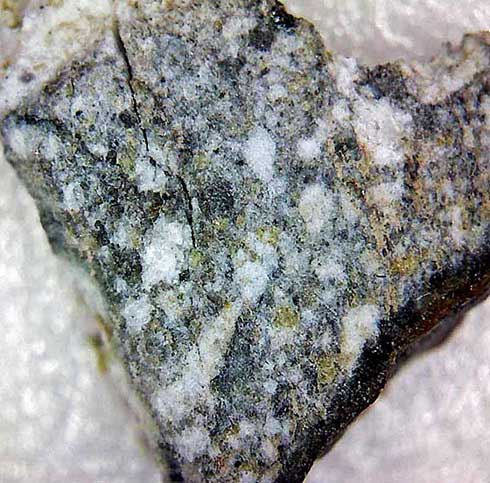By Staff Reporter
A rare lunar meteorite at Natural History Museum Abu Dhabi gives insights into the Moon
Have you ever looked at the Moon and wondered, beyond grainy footage from the Apollo missions, what it’s really like up there?
Visitors to the Natural History Museum Abu Dhabi will soon be able to find out for themselves when a fascinating lunar meteorite, Northwest Africa 12691, or NWA 12691, goes on display.
Lunar meteorites are among the rarest celestial treasures, with relatively few known specimens. They’re also helpful to scientists as they come from the vast parts of the Moon’s surface that space missions have not sampled.
They’re made of material ejected from the Moon’s surface due to asteroid or comet impacts and then fall to Earth as meteorites. These are essentially a gift from the Moon, delivered by nature, without the expensive cost of a spacecraft mission.
An extraordinary find
The NWA 12691 meteorite, discovered in the Western Sahara desert in January 2017, is one of these extraordinary finds. Its mineral composition offers evidence of several impacts on the lunar surface.
But the impact didn’t happen just a few short years ago, according to Hamad Younis Al Marzooqi, an Assistant Curator at the museum: “After it was ejected from the Moon, the meteorite would have orbited around the Earth for several thousand years and then maybe it was lying in the desert undetected for a thousand more,” he explains. “We call it a breccia as it is composed of a variety of mineral and rock fragments that were more or less shocked and mixed by many impacts before to be cemented together and finally ejected.”
But why are so many meteorites, lunar or otherwise, found in deserts? “It is mainly because dry deserts allow to preserve them from alteration. In addition, meteorites stand out through their dark colour,” explains Al Marzooqi, “So it’s not that they don’t fall in other places – there is evidence of one being found on a tennis court in France last year. They simply have more chance of being found in a desert because they look so different than anything else around.”
The Natural History Museum Abu Dhabi’s lunar meteorite specimen weighs 13.5kg, so it is fortunate that it fell where it did. However, Al Marzooqi reveals that it would have been much larger on ejection: “They lose mass when they pass through the Earth’s atmosphere and sometimes even shatter in hundred to thousand fragments, and in rare cases portions break off when landing on the Earth’s surface.”
More meteorite specimens
The museum is currently collecting further meteorite specimens as part of their acquisition process which Al Marzooqi feels will be an important attraction in the Story of Earth gallery. It will also include a portion of the famous meteorite that landed outside the town of Murchison, Australia in 1969, just two months after the first man landed on the Moon. Within it, scientists found presolar grains, also known as stardust, formed during the explosion of stars, long before the formation of our Solar System.
It’s all exciting stuff, especially for a man who was fascinated by space, the planets and stars from elementary school age when he had his first astronomy lesson. “That whole world drew me in,” recalls Al Marzooqi. “I loved astronomy and had so many questions. I actually wanted to pursue an academic degree in space and astronomy but fate had other ideas and ended up studying geology and palaeontology which was broader.”
To do that, Al Marzooqi travelled with a cohort of students from the UAE to study at the University of Arizona in Tucson, a hotspot for geology, palaeontology and mineralogy. This also included a year’s study in Italy where he visited an ancient Etruscan village in Umbria. “That was quite emotional,” he recalls, “to see and touch houses where people lived during the 6th century BC.”
The Story of Earth gallery at the Natural History Museum Abu Dhabi is poised to become a huge attraction
The Story of Earth gallery at the Natural History Museum Abu Dhabi is poised to become a huge attraction
Supplied
The Natural History Museum Abu Dhabi’s visitor journey will reach much further back in history than civilizations. From the Big Bang theory explaining how the Universe began, to the Solar System and the formation of the Earth, the specimens to help tell its story in terms of time and scale.
Al Marzooqi is also involved in the Evolving World gallery, where visitors will be drawn to its dinosaur and fossil exhibits. In a fitting crossover from the gallery before it, the prehistoric creatures it features went extinct 66 million years ago by an asteroid colliding with Earth. About 10 kilometres in size, it hit the Yucatan Peninsula with devastating effects.
“Showing visitors how the dots connect is why we are so busy with these galleries at the moment,” admits Al Marzooqi. “We are detailing the narrative, sourcing specimens and deciding where they will go, so there’s a lot happening. I love the variety the museum offers me and I can’t wait for our visitors to arrive.”
He is impressed by the number of young Emiratis now seeking careers in sciences connected to the museum: “I think younger people are growing up with a lot more critical thinking due to the digital information that’s now available, so they’re inspired and curious.”
A gift from the Moon to Abu Dhabi
That will surely increase when the museum opens as Al Marzooqi points out, this will be a place that offers everything: dinosaurs, meteorites, insects, marine life and all the natural beauty of our world presented in a dynamic, educational, and entertaining package. “People may think, ‘I’m only going to see dinosaurs’ but once there, they’ll be captivated by so much more. The museum highlights how every single thing on Earth and in space is interconnected.
“It’s the reason I’m putting my heart and soul into the museum,” he says. “I want the generations coming up after me to be inspired by us. It will give them a whole new perspective and that’s not just our museum, it includes the wider museums in Saadiyat Cultural District. It is a very exciting period for Abu Dhabi and I think it is going to be revolutionary for the entire region.”


